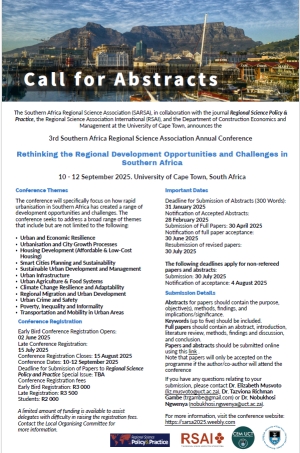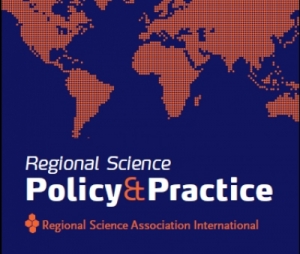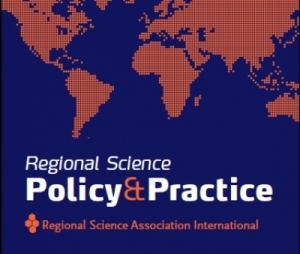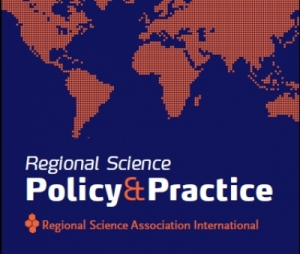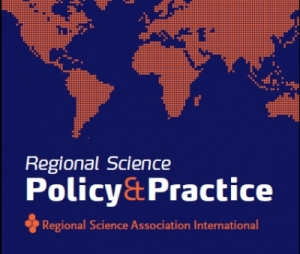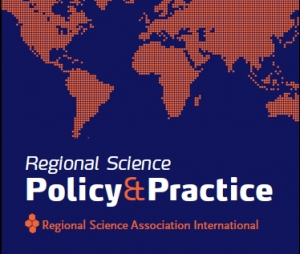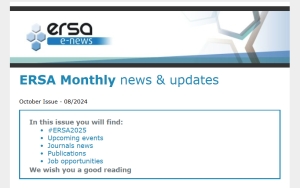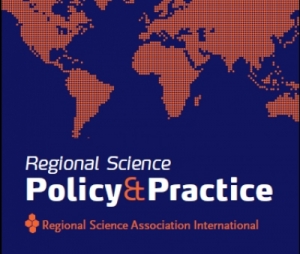Peter Nijkamp Research Award
Elisabete Martins
Call for papers | 3rd Southern Africa Regional Science Association Annual Conference, 10-12 September 2025, University of Cape Town, South Africa
The Southern Africa Regional Science Association (SARSA), in collaboration with the journal Regional Science Policy &The Southern Africa Regional Science Association (SARSA), in collaboration with the journal Regional Science Policy &Practice, the Regional Science Association International (RSAI), and the Department of Construction Economics andManagement at the University of Cape Town, announces the
3rd Southern Africa Regional Science Association Annual Conference
Rethinking the Regional Development Opportunities and Challenges in Southern Africa
10-12 September 2025, University of Cape Town, South Africa
Conference Themes
- Urban and Economic Resilience
- Urbanisation and City Growth Processes
- Housing Development (Affordable & Low-Cost Housing)
- Smart Cities Planning and Sustainability
- Sustainable Urban Development and Management
- Urban Infrastructure
- Urban Agriculture & Food Systems
- Climate Change Resilience and Adaptability
- Regional Migration and Urban Development
- Urban Crime and Safety
- Poverty, Inequality and Informality
- Transportation and Mobility in Urban Areas
Key dates
Notification of Accepted Abstracts: 28 February 2025
Submission of Full Papers: 30 April 2025
Notification of full paper acceptance: 30 June 2025
Resubmission of revised papers: 30 July 2025
The following deadlines apply for non-refereed papers and abstracts:
Submission: 30 July 2025
Notification of acceptance: 4 August 2025
More info at: https://sarsa2025.weebly.com/
Call for Papers | RSPP Special Issue: Understanding Spatial Disparities in the Global South: Evidence and Policy Implications

Regional Science Policy & Practice (RSPP)
Call for Papers Special Issue: Understanding Spatial Disparities in the Global South: Evidence and Policy Implications
Guest Editor: Carolina Guevara Rosero, Departamento de Ciencias Administrativas, Escuela Politécnica Nacional - This email address is being protected from spambots. You need JavaScript enabled to view it.
Developing countries, currently denominated as Global South, are characterized by spatial disparities combined with rapid urbanization, demographic change, and shifting economic structures. These disparities raise urgent questions for policy, as they affect opportunities for growth, the provision of public goods, and the achievement of inclusive and sustainable development. Addressing them requires both robust evidence and a clear understanding of how policy interventions can mitigate inequalities across regions.
This Special Issue invites contributions that advance knowledge on the drivers, consequences, and policy responses to spatial disparities in the Global South. We particularly welcome research that offers actionable insights for policymakers, practitioners, and international organizations, as well as comparative analyses that highlight lessons transferable across contexts.
We welcome high-quality contributions that explore, but are not limited to, the following themes:
- Policy frameworks and strategies to reduce regional inequalities.
- Evaluation of place-based vs. people-based policies in the Global South.
- The effectiveness of infrastructure, transport, and connectivity policies in reducing disparities.
- Agricultural and rural development policies and their spatial impacts.
- Urbanization, housing, and spatial planning policies addressing segregation and inequality.
- Health, education, quality of life and social policies with a territorial perspective.
- Migration, labor mobility, crime, spatial segregation and their implications for regional policy.
- Governance, decentralization, and institutional arrangements for territorial development.
- Innovative tools and methodologies for policy evaluation in regional and urban contexts.
- Lessons from comparative policy experiences across countries in the Global South.
We encourage both theoretical and empirical studies, as well as interdisciplinary approaches that combine insights from economics, geography, sociology, political science, and development studies.
All manuscripts will be submitted via the Regional Science Policy & Practice online submission system (https://www.editorialmanager.com/rspp/). Papers should have between 6000 and 8000 words. Authors should indicate in the cover letter that the paper is submitted for consideration for publication in this special issue “Understanding Spatial Disparities in the Global South: Evidence and Policy Implications”, otherwise, your submission will be handled as a regular manuscript. Regional Science Policy & Practice is a gold open access journal. This means that articles accepted for publication will be subject to the payment of an Article Publishing Charge (APC). Standard fees are described in detail on the journal home page.
Submission deadline: March 31st, 2026
Call for Papers | RSPP Special Issue on Sustainability and regional challenges of GVC-dependent FDI development path
RSPP Call for Papers
Special Issue on Sustainability and regional challenges of GVC-dependent FDI development path
Editors
Magdolna Sass - Institute of World Economics, Hungary; This email address is being protected from spambots. You need JavaScript enabled to view it.
Zoltán Gál - University of Pécs, Hungary; This email address is being protected from spambots. You need JavaScript enabled to view it.
This special issue delves into the sustainability of Global Value Chain (GVC) dependent Foreign Direct Investment (FDI) development in dependent market economies (DME) of Central and Eastern Europe (CEE) and Latin America (Mexican case). It examines the regional impacts and transformative effects of GVC-dependent FDI, particularly in the lower value-added segments of production and assembly. The issue will compare the growth experiences of DME economies, address the challenges posed by recent economic disruptions, and explore the readiness of these regions for Industry 4.0. By proposing alternative models and strategies, this issue aims to foster a sustainable and resilient economic future for CEE and Mexican regions within the global economic landscape.
Keywords
- Sustainability
- Global Value Chains (GVCs)
- Foreign Direct Investment (FDI)
- Central and Eastern Europe (CEE)
- Regional Development
- Industry 4.0
Manuscript submission information:
All submissions must be original and may not be under review elsewhere. All manuscripts will be submitted via the Regional Science Policy & Practice online submission system (https://www.editorialmanager.com/rspp/). Authors should indicate in the cover letter that the paper is submitted for consideration for publication in this special issue “Sustainability and regional challenges of GVC-dependent FDI development path”, otherwise, your submission will be handled as a regular manuscript.
- Submissions open until March 31, 2025
Call for Papers | RSPP Special Issue on Sustainability in the Middle East
RSPP Call for Papers
Special Issue on Sustainability in the Middle East
Editors
Umut Türk - Abdullah Gül University, Kayseri, Türkiye; This email address is being protected from spambots. You need JavaScript enabled to view it.
Armağan Teke Lloyd - Abdullah Gül University, Kayseri, Türkiye; This email address is being protected from spambots. You need JavaScript enabled to view it.
Current circumstances highlight the pressing need for immediate action, particularly in the domain of SDG 16—Peace, Justice, and Strong Institutions for the Middle East. Interconnected socioeconomic factors necessitate prompt attention to goals 10 (Reduced Inequality), 5 (Gender Equality), and 8 (Decent Work and Economic Growth). The Middle East grapples with distinct challenges, including political instability, water scarcity, and socio-economic disparities. Issues of inequality, unemployment, and social exclusion are prevalent in many Middle Eastern countries. Migration flows in the region have been significant, driven by factors such as economic opportunities, political instability, conflict, and social reasons. In addressing these multifaceted challenges, the SDGs offer a relevant framework, emphasizing critical goals such as peace, quality education, decent work, and reduced inequality. This special issue aims to address emerging research challenges and novel approaches/findings in this field.
Keywords
Sustainable Development, Middle East, Peace, Environment
Manuscript submission information:
All submissions must be original and may not be under review elsewhere. All manuscripts will be submitted via the Regional Science Policy & Practice online submission system (https://www.editorialmanager.com/rspp/). Authors should indicate in the cover letter that the paper is submitted for consideration for publication in this special issue “Sustainability in the Middle East”, otherwise, your submission will be handled as a regular manuscript.
- Submissions open until October 15, 2025.
Call for Papers | RSPP Special Issue on A New Toolbox for Novel Research in Regional, Urban and Spatial Studies
RSPP Call for Papers
Special Issue on A New Toolbox for Novel Research in Regional, Urban and Spatial Studies
Editor
Katarzyna Kopczewska - University of Warsaw, Faculty of Economic Science, Poland. Email: This email address is being protected from spambots. You need JavaScript enabled to view it.
Novelty in research is rooted in critical observation, theory, data or methods. There is no progress in science without these elements. Very often the focus is on the first two, while the last two are neglected. The aim of this special session is to collect papers whose strength lies in data and/or methods. They should open up new avenues for regional research, allowing new questions to be asked and the same phenomena to be seen with new eyes. Taking a new approach is risky - it may not always be successful and convincing to others. But it can also bring great scientific gain and stimulate scientific debate, which is the seed of conferences and publications. This session aims to stimulate discussion on novel methods and data that can be used in regional, urban and spatial studies.
Welcome topics include, among others:
- spatial machine learning
- links between spatial statistics, spatial econometrics and spatial machine learning
- novel approaches to dealing with low granularity spatial data
- methods, tricks and approaches for dealing with spatio-temporal data
- new algorithms for dealing with big data and streaming data
- challenges of aggregating spatial data of different granulation - coherent databases of pixel, raster, line, regional, point, polygon data
- new sources of data that can be used in regional, urban and spatial studies.
- what is right - theory-driven, problem-driven or data-driven science?
Manuscript submission information:
All submissions must be original and may not be under review elsewhere. All manuscripts will be submitted via the Regional Science Policy & Practice online submission system (https://www.editorialmanager.com/rspp/). Authors should indicate in the cover letter that the paper is submitted for consideration for publication in this special issue “A New Toolbox for Novel Research in Regional, Urban and Spatial Studies”, otherwise, your submission will be handled as a regular manuscript.
- Submissions open until January 15, 2025.
Call for Papers | RSPP Special Issue on Regional Sustainable Development in the Global South
RSPP Call for Papers
Special Issue on Regional Sustainable Development in the Global South
Editors
Abdul Shaban, Tata Institute of Social Sciences, Mumbai, This email address is being protected from spambots. You need JavaScript enabled to view it.
The Global South is undergoing an urban revolution with profound consequences to its society, economy, culture, polity, demography, human behaviour, and built and natural environments. Many associates this urbanism to arrhythmic (Lefebvre, 2004; Shaban and Datta, 2019) development of Global South through ‘fast urbanization’ (Datta and Shaban, 2017) based on ‘fast policies’ (Peck and Theodore, 2015) from Global North, while others locate the changes in the paradigm of new economic development and social liberation (Brugmann, 2009). Some studies have located the urbanization in the Global South within the essence of northern urbanity or ‘planetary’ urbanism (Brenner and Schmid, 2015), while others have differentiated its character and called it ‘Southern Urbanism’ (Schindler, 2017). ‘Fast’ urbanization and city building is seen as utopia by the post-colonial states of the Global South to overcome their economic underdevelopment. The amassed investments in cities by both the private sector and the entrepreneurial states are sharpening the rural-urban divides in development with massive consequences to both the poverty and aspiration led migration to urban centres, especially to the mega cities. Theme based urbanism and city building from garden city, ecocity, intelligent city to smart city has emerged as a trope for urban future and sustainability.
This urban moment in the Global South is caught in many contradictory processes: slow societies with fast urbanism; burgeoning urban system with imbalanced hierarchies of cities; increased city building and rising houselessness and inadequate social and physical infrastructure; rising means of transport with increased traffic congestions; economic growth with increased inequalities; increased accumulation of wealth in urban centres with increased dispossession of the rural; increased nationalism with increased exoticism; increased emphasis on democracy with decreased citizens’ participation; increased size of government with declining social welfare; increased planning with rising informality; rising economic development with increased adverse environmental consequences; rising middle class with sharpening ethnic divides; increased policing with rising crimes, etc.
In the above context, we invite well-researched papers and case studies from the Global South (Latin America, Africa, Asia, and Oceania) around the following sub-themes (with discussion on implications to the urban future),
- Urban planning and local context
- Urban infrastructure (including digital Infrastructure)
- Urban mobilities
- Urbanization and democratic participation
- Socio-spatial segregation and exclusion in cities
- Urban violence and community resilience
- Urban environment and climate action
- Engagement with sustainable urbanization
Manuscript submission information:
All submissions must be original and may not be under review elsewhere. All manuscripts will be submitted via the Regional Science Policy & Practice online submission system (https://www.editorialmanager.com/rspp/). Authors should indicate in the cover letter that the paper is submitted for consideration for publication in this special issue “Regional Sustainable Development in the Global South”, otherwise, your submission will be handled as a regular manuscript.
- Submissions open until December 31, 2024.
References
Brenner N and Schmid C (2015) Towards a New Epistemology of the Urban? City 19 (2-3): 151–182.
Brugmann J (2009). Welcome To Urban Revolution: How Cities Are Changing The World. New Delhi: HarperCollins.
Datta A and Shaban A (eds) (2016) MegaUrbanization in the Global South: Fast Cities and New Urban Utopias of the Postcolonial State. New York: Routledge.
Lefebvre H (2004) Rhythmanalysis: Space, Time and Everyday Life (Translated by Stuart Elden and Gerald Moore). Paris: Continuum.
Peck J and Theodore N (2015) Fast Policy: Experimental Statecraft at the Thresholds of Neoliberalism. Minneapolis: University of Minnesota Press.
Schindler S (2017) Towards a paradigm of Southern urbanism. City 21(1): 47-64.
Shaban A and Datta A (2019) Towards 'Slow' and 'Moderated' Urbanism. Economic and Political Weekly 54(48):36-42.
Call for Paper | RSPP Special Issue on Post-Covid Latin American Economies: countries, regions and cities

Regional Science Policy & Practice (RSPP)
Call for Papers Special Issue: “Post-Covid Latin American Economies: countries, regions and cities”.
Editor
Carlos Azzoni - Department of Economics, University of Sao Paulo, Brazil; This email address is being protected from spambots. You need JavaScript enabled to view it.
Following the containment of the COVID-19 pandemic, Latin American countries focused on fostering recovery processes, which have been heterogeneous across the region. The pandemic not only had negative effects but also compelled many companies and workers to promote remote working, accelerating a process that would likely have taken many years to reach the levels observed during the health crisis. Moreover, the skills developed during this period continue to be utilized by companies and workers. It is probable that many tasks now carried out from home and meetings that previously required travel are now conducted online. Likewise, delivery firms that experienced a significant increase in their activities during the pandemic continue to experience high levels of demand.
This special issue focuses on the changes that have emerged, especially at the subnational level, and how they have influenced the economic recovery processes.
Regardless of the topic chosen, the papers should have a short introductory section describing the overall impact of the pandemic on the countries' economy as a whole and on their regions and/or cities, depending on the geographical scale chosen, and the path of recovery up to recent times.
The papers may concentrate on specific topics, such as labor market modifications, poverty, income inequality, social interactions, political preferences, or other issues chosen by the researchers.
Keywords
COVID-19 economic impacts; Recovery post COVID-19; Socioeconomic changes; Regional inequality; Urban changes
Manuscript submission information:
All submissions must be original and may not be under review elsewhere. All manuscripts will be submitted via the Regional Science Policy & Practice online submission system (https://www.editorialmanager.com/rspp/). Authors should indicate in the cover letter that the paper is submitted for consideration for publication in this special issue “Post-Covid Latin American Economies: countries, regions and cities”, otherwise, your submission will be handled as a regular manuscript.
- Submissions open until December 31, 2024.
ERSA Monthly E-news - October2024
|
Call for Papers | RSPP Special Issue on Sustainable Development of Afghanistan and Iran

Regional Science Policy & Practice (RSPP)
Call for Papers Special Issue: Sustainable Development of Afghanistan and Iran
Editor
Abdul Shaban - School of Development Studies, Tata Institute of Social Sciences, Mumbai, India, This email address is being protected from spambots. You need JavaScript enabled to view it.
Given, the difficult political history and development situation, Afghanistan and Iran requires deeper analysis of its existing situation and human practices to learn and track itself on the path of sustainable development. The major challenge before the country is how to evolve a war economy into a peaceful and sustainable economy. The proposed special issue of Regional Science Policy & Practice will attempt to understand the possibilities of development of Afghanistan and Iran in the context the regional history and current reality, with the following major subareas (though not limited to),
- From war to peace, prospects for regional development in Afghanistan and Iran
- Regional philosophy of peace and development and spatial practices
- Economic structure and potentials of growth
- Inequality, poverty, and potential for sustainable community development
- The role of trade, especially the regional trade (India, Pakistan, China, Iran, and Central Asian Countries), and investment in development,
- Urban centers, regional growth (including rural-urban), and development
- Educational Institutions, skills, and human capital
- Women and development
- Sustainable Development Goals in the Regions of Afghanistan and Itan
Manuscript submission information:
All submissions must be original and may not be under review elsewhere. All manuscripts will be submitted via the Regional Science Policy & Practice online submission system (https://www.editorialmanager.com/rspp/). Authors should indicate in the cover letter that the paper is submitted for consideration for publication in this special issue “Sustainable Development of Afghanistan and Iran”, otherwise, your submission will be handled as a regular manuscript.
- Submissions open until December 31, 2024.
Call for Papers | RSPP Special Issue: Regional Development in Central Asia: situation and challenges

Regional Science Policy & Practice (RSPP)
Call for Papers Special Issue: Regional Development in Central Asia: situation and challenges
Guest editors
Makhabbat Ramazanova - University Portucalense, Portugal, This email address is being protected from spambots. You need JavaScript enabled to view it.
Andrey Shenin - Narxoz University (Almaty, Kazakhstan), This email address is being protected from spambots. You need JavaScript enabled to view it.
Farhod Ahrorov - Samarkand branch of Tashkent state university of economics, This email address is being protected from spambots. You need JavaScript enabled to view it.
Central Asia, with its strategic geographical location, rich historical past and economic growth, has consistently attracted the interest of the international academic community. In order to ensure sustainable, inclusive and resilient development of the region, it is first and foremost necessary to explore the issues, opportunities and challenges of regional development in Central Asia, necessary for effective policymaking, international cooperation and improving the well-being of people in the region. There are many emerging issues in this context, such as sustainability and stability, institutions and development, legal frameworks for sustainable development, economic geography, tourism for regional development, regional policy analysis, political economy, spatial economics and planning, environmental and ecological analysis, and transport networks among others. Recognising the need for high-quality research within a specific timeframe required to sustain the progress of human society, this special issue aims to provide a platform consistent with the overarching topic of the journal, fostering discussion and presenting cutting-edge research on the various challenges and opportunities of regional development in Central Asia.
Keywords
Central Asia, regional development, sustainability, economic growth.
Manuscript submission information:
All submissions must be original and may not be under review elsewhere. All manuscripts will be submitted via the Regional Science Policy & Practice online submission system (https://www.editorialmanager.com/rspp/). Authors should indicate in the cover letter that the paper is submitted for consideration for publication in this special issue “Regional Development in Central Asia: situation and challenges”, otherwise, your submission will be handled as a regular manuscript.
- Submissions open until December 31, 2024.
Note:
As an open access journal with no subscription charges, a fee (Article Publishing Charge, APC) is payable by the author or research funder to cover the costs associated with publication. This ensures your article will be immediately and permanently free to access by everyone. The Article Publishing Charge for this journal is EUR 1596, excluding taxes.
The RSPP editorial team are pleased to cover APCs for a selected number of accepted articles that are unable to secure sufficient funding. Authors can indicate whether they wish to be considered for this waiver at the beginning of the submission process or by emailing This email address is being protected from spambots. You need JavaScript enabled to view it.
All submitted papers should address significant issues pertinent to the theme of this issue and fall within the scope of Regional Science Policy & Practice (RSPP). Criteria for acceptance include originality, contribution and scientific merit. All manuscripts must be written in English with high scientific writing standards. Acceptance for publication will be based on referees’ and editors’ recommendations, following a detailed peer review process.
Why publish in this Special Issue?
- Special Issue articles are published together on ScienceDirect, making it incredibly easy for other researchers to discover your work.
- Special content articles are downloaded on ScienceDirect twice as often within the first 24 months than articles published in regular issues.
- Special content articles attract 20% more citations in the first 24 months than articles published in regular issues.
- All articles in this special issue will be reviewed by no fewer than two independent experts to ensure the quality, originality and novelty of the work published.
About Us
The Regional Science Association International (RSAI), founded in 1954, is an international community of scholars interested in the regional impacts of national or global processes of economic and social change.

